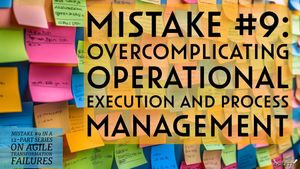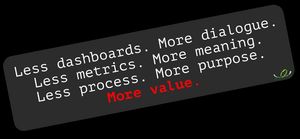Mistake #9: Overcomplicating Operational Execution and Process Management
The dashboard was beautiful. Bursting with color-coded burndown charts, capacity bars, cumulative flow diagrams, and digital post-its in a dozen columns. The transformation lead stood proudly in front of it, pointing to each metric with precision.
"See? We're Agile. We have stand-ups, retros, Jira dashboards, even OKRs integrated into our PI planning!"
But down the hallway, a developer sat quietly at her desk, staring at a ticket she'd moved three times this week.
"Why are we building this? What problem are we solving? And do we even care if it actually helps the user?"
That ticket would be delivered. It would meet the "Definition of Done." It would show up as a completed story point on a dashboard.
And it would never be used.
If that sounds uncomfortably familiar, this one’s for you. If not—read on anyway. You may be overcomplicating your way into irrelevance without even knowing it. So, let’s do it!

The Mistake: Overcomplicating Agile Execution
Agile is simple. But being Agile is not.
What was meant to be a lightweight, value-driven way of working often turns into a bureaucratic monster, layered with complex tooling, rigid ceremonies, and metrics divorced from meaning. The core of this mistake is a subtle but powerful shift: from focusing on delivering value to focusing on managing the appearance of being Agile.
Let’s break it down.
How This Mistake Shows Up
Overthinking the Agile Process: Teams debate whether Scrum or Kanban is more “mature,” whether their refinement meetings are in the right week, and whether their velocity trends are stable—while nobody questions why they're building what they’re building.
Over-Reliance on Tools and Metrics: Agile becomes a Jira implementation. Or a Miro board jungle. Or a SAFe instance where every task has its own slide deck. Dashboards replace dialogue. Metrics replace meaning.
Focus on Output, Not Outcome: “We delivered 120 story points last sprint” becomes a badge of honor, regardless of whether those story points actually solved a problem or created business impact.
Focus on the Plan, Not the Planning: Planning becomes performance. Hours spent creating glossy PI plans and dependency maps with the illusion of certainty, rather than treating planning as an adaptive, continuous conversation.
Planning Activities Instead of Business Value: Teams are asked to “plan the next 10 weeks” by breaking down effort—not by identifying and sequencing small, meaningful slices of customer value.
The tragic irony? These behaviors look like maturity. They feel like control. But they lead us further away from what Agile was always meant to achieve: delivering value through adaptive, collaborative, incremental work.
Signs You Might Be Stuck in This Trap
- Your teams talk more about velocity than value
- Tooling complexity is growing faster than your delivery capabilities
- Planning sessions feel like compliance activities, not collaborative problem solving
- Stakeholders get reports—not working software
- People can’t explain why they’re doing what they’re doing—only that it’s “part of the process”
Consequences: When Complexity Kills Agility
Short-term:
You might see false positives. Beautiful charts. Highly refined backlogs. Loads of tickets moving every day. Leaders feel reassured—temporarily.
Long-term:
The rot sets in. Teams disengage. Value delivery slows. Quality erodes. No one dares to change the process because “this is how Agile is supposed to work.” Innovation halts. Agile becomes a theatre—well-scripted but hollow.
Organizationally:
This behavior cements a focus on predictability over adaptability. Leaders double down on planning cycles and metrics when things go wrong, further suffocating autonomy and learning.
A Tale of Two Transformations
The Overengineered Failure:
A large company went “full SAFe.” Tooling integrations, detailed PI plans, quarterly objectives and key results—all in place. But delivery velocity dropped. Customer satisfaction tanked. Why? The teams were drowning in process debt. Agile became a system to navigate—not a system that served them. Value delivery was reduced to a metric, and nobody owned the problem space anymore.
The Simplified Success:
Another organization-a startup—focused on outcomes. They picked just enough structure to enable flow. Tools were extremly lightweight. Backlogs contained hypotheses of business outcomes, not just features. They ran weekly experiments. Planning was lean, fast, and collaborative. They were chaotic—but adaptable. And they were delivering customer value. Not perfectly. But purposefully. Not as fast as possible but with the most impact they could imagine.
The difference? One optimized for certainty. The other optimized for learning.
Why We Must Avoid This Mistake
This isn't just about process bloat. Overcomplicating execution leads to cultural decay. Teams lose sight of their purpose. Autonomy gives way to compliance. Creativity is stifled. And worst of all—customers stop being at the center.
Agile was never about being safe. It was about being responsive.
We don’t need more frameworks. We need more clarity. More courage. And more willingness to ask, “What are we really trying to achieve here?”
What Happens If We Get It Right?
If we avoid this trap, something beautiful happens:
- Planning becomes a learning activity, not a prediction exercise
- Metrics serve insight, not oversight
- Teams build smaller, smarter, faster—and care more deeply about what they’re building
- The organization becomes lighter, faster, more focused—and aligned with purpose
Agile becomes invisible. What’s visible is value.
Reflective Questions for You and Your Teams
- Are we measuring what matters—or just what’s easy?
- When was the last time we changed our process based on real feedback?
- Are we planning to control—or to planning to learn?
- Do we understand our customers’ problems—or just our backlog items?
- What would we simplify tomorrow if we dared?
Conclusion: Cut Through the Noise
Agile doesn’t need to be complicated to be powerful. In fact, its power lies in its simplicity, clarity, and adaptability.
If you find your Agile process has become a maze—stop. Step back. Refocus.

- Less dashboards. More dialogue.
- Less metrics. More meaning.
- Less process. More purpose.
- More value.
Because Agile isn’t about doing more things right.
It’s about doing the right things. One valuable slice at a time.
Additional Resources
- Reinventing Organizations by Frederic Laloux – for insight into post-hierarchical structures
- Measure What Matters by John Doerr – to rethink how you use OKRs and metrics
- Start With Why by Simon Sinek – for rediscovering purpose in transformation
- Articles #1–8 in this series: Find them here
Last updated May 27, 2025
